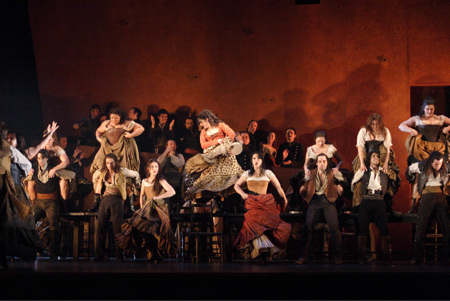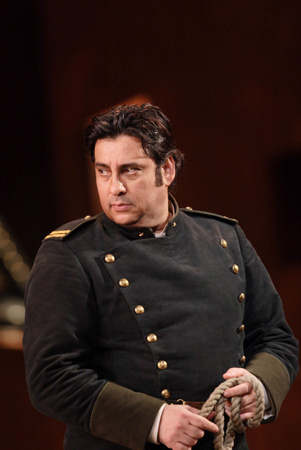Other Links
Editorial Board
- Editor - Bill Kenny
- London Editor-Melanie Eskenazi
- Founder - Len Mullenger
Google Site Search
SEEN
AND HEARD OPERA REVIEW
Bizet, Carmen:
various soloists, The Royal Opera Chorus and
Orchestra. Conductor: Daniel Oren. Royal Opera House,
Covent Garden. 25.3.2008 (JPr)
Continuity is a wonderful thing. When I looked back at
what I wrote in December 2006 when Francesca
Zambello’s production was first staged, I began: A
chicken, a donkey and a beautiful black stallion …
what no bull? Well quite a lot actually. Raymond
Gubbay’s ‘in-the-round’ crowd-pleasing extravaganzas
at the Royal Albert Hall have had quite an affect on
Covent Garden, its three most recent new productions
of repertory fare, Faust, Tosca, and
now, Carmen have tried to bring some of that
‘spectacle’ to the Royal Opera House stage. No expense
spared, never have one extra chorus member or actor
when you can have two; allow the eye and ear (plus
possibly baser instincts) to be engaged but never the
brain which might as well have been checked in at the
cloakroom along with the bags of Christmas shopping.
At times the set becomes all too over-populated.
The Act I Choeur des gamins could do with a few
of the over-eager urchins being sent off to the
BBC TV show to audition for Oliver and everyone
loitering in the Square could hardlyhave failed to
overhear Carmen’s seduction of Don José and their
‘secret’ plan for her escape. The foot-stamping,
whooping and seemingly authentic Flamenco dancers lent
much authenticity to the ‘tavern’ scene -
everyone else did to the claustrophobic one in the
mountain pass - yet why at moments of dramatic
confrontation must the eye be distracted by a couple
of extras abseiling down the side walls? The Act IV
procession to the bullfight is still spoilt by a Billy
Elliot-wannabe being thrown about and then
somersaulting across the front of the stage trying to
illicit ‘oohs’ and ‘aahs’ from the audience - and
failing - because most watching knew something more
serious was about to happen. What about the animals?
Well to make it worthwhile for them, after the
donkey's appearance in the opening scen, it turned up
again in Act III and Carmen rode in to her fate
on Escamillo’s horse in the last act. As for the
chicken - I seem not to have seen it this time.
What was illuminating in a recent broadcast from The
Met of Manon Lescaut

Act II Ensemble
I still stand by that for the most part yet I
found the use of Tanya McCallin’s single
ochre-coloured set even more ingenious this second
time. It presents the Act I town square (wasn’t
that orange tree in the centre a little greener last
time?), the Act III smugglers’ encampment and the Act
IV scene outside the bullring in Seville. It is less
successful at showing us Lillas Pastia’s tavern,
although it does allow Escamillo his entry on Louis
the horse.

Marcelo Álvarez - Don José

Nacy Fabiola Herrera - Carmen
Thankfully the PC-brigade hasn’t had time to catch up
with for this opera yet for such lines (in
translation) as ‘We watch the fragrant smoke rise in
the air’ when the women come out of the factory for a
ciggie break. Also what about Escamillo’s ‘Tell me
your name so next time I kill a bull I shall speak
it’. Alright, I do know bullfighting is an EU-protected
activity, but even so?
We had a Carmen and Don José who had recently sung
these same roles together at The Met. Since both were
latins, the former Spanish and the later Argentinian,
then I am sure the passion and jealously required was
indeed in their blood and did not have to be taught to
them, as hinted at by Marcelo
Álvarez
in his
recent interview with me . But, though the
costumes were undoubtedly Goyaesque when
Álvarez
and others had their Cordobés
hats on, they seemed closer to the Gauchos of the
tenor’s homeland than to Seville.
One of the world’s new Carmens, Nancy Fabiola Herrera,
is a genuine mezzo-soprano and has vocally exactly the
range of voice required for the role, very reminiscent
of Agnes Baltsa, whom I saw a couple of times in the
1980s as Carmen at Covent Garden. Perhaps on this
first night she was just a little reticent;
flirty and flighty rather than a feral sensual animal.
There certainly was little bare flesh to be seen and
when she concealed Don José’s head under her skirt in
Act II it seemed all in good fun and only mildly
sexual. To her credit though, she played the
castanets very well, danced alluringly and made the
audience care about her demise in the end. When she
cried out
‘Jamais Carmen ne cédera! Libre elle est née et libre
elle mourra!’ (‘No, no! Carmen will not give way! Free
she is born and free she dies!’) it had exactly the
right climactic emotional impact.
Her Don José, Marcelo
Álvarez,
is a very popular singer at Covent Garden and there is
every reason to hear why, once he starts to
sing. He had an announcement made for him before
the performance because he was a little under the
weather, but it did not seem to affect his voice
unduly: he appeared to be taking sips of water and
wiping his nose from time to time and that was it
really. Initially, did worry that he would be
singing everything at forte but he revealed
well-controlled pianissimos in duet with Micaëla and
excellent breath control in his heart-felt Act II
aria. He was a bit of a doe-eyed booby in Act I with
none of the angst of the innocent Corporal still
trying to shake off former life of a priest, but
when he got angry, wanting to slap Carmen, it seemed
very natural, as it did in Act III when he kissed her,
before wiping the taste away and sneeringly dismissing
her. If ever Covent Garden gets to see his Otello,
that seems likely to be the role he was born to sing.
I am in danger of getting boring about this, I know
but the casting of the smaller roles was more
troublesome: there was only one Jette Parker
Young Artist singer or graduate among them all.
Surely in an ensemble work like this , more use could
be made of ‘home grown’ talent. I do not mean only
British singers here but, yes, a fair mix of those
plus some of the ‘Young Artists’. Going to the opera
is nowadays like going to a Premier League football
match and trying to pronounce the players’ names.
Even so, Jacques Imbrailo from the Jette Parker scheme
was a notable Moralès, Elena Xanthoudakis repeated her
perky Frasquita, Jana Sýkorová has sung Carmen herself
and that could be heard in her appealing Mercédès. The
smugglers Roderick Earle and Harry Nicoll were rather
insignificant and since they are both Royal
Opera veterans, saying this might go slightly against
my request for a ‘home’ team. My argument remains
however, that I want these roles to give experience to
younger talent.
Susan Gritton did not seem vocally entirely at ease as
Micaëla with one mishap during her Act III aria but
she had the gamine quality and naiveté important for
her character. Kyle Ketelsen’s Escamillo had all the
good looks and swaggering braggadocio necessary and he
sat well on his horse too. But where was the voice
necessary for ‘Toreador, en garde!’ : perhaps no one
has the élan to make magic with this any more.
Overall, what we were given here was a
straight-forward old-fashioned night at the opera of
the sort I believed long-relegated to fond memory, at
least in this country. Basically this was
straight-forward story-telling, against a
nothing-held-back highly-charged verismo account of
the score from the extremely competent Israeli
conductor Daniel Oren and his orchestra who were on
top form (even better than with Pappano in this work)
matched with broad acting and loud singing. This
was actually the 512th performance of Carmen at
Covent Garden and that large total is the
record-holder here so it must be doing something
right. I realised I had barely breathed during
Álvarez’s
exquisite rendition of Don José’s ‘La fleur que tu
m’avais jetée’
and
when
he confronted, hesitated and finally despatched Carmen
this too suggested I would be coming back for more
sometime. By which I mean more grand opera.
Jim Pritchard
Photographs © Catherine Ashmore
